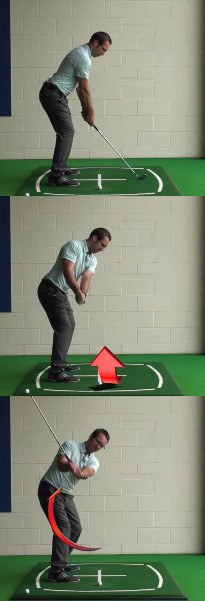You're Correct!
 An on plane golf swing is something that golfers wish for every day, but understanding an on plane golf swing is the first step to achieving one.
An on plane golf swing is something that golfers wish for every day, but understanding an on plane golf swing is the first step to achieving one.
Many golfers dont achieve an on plane golf swing due to rounded shoulders at address. This poor posture will limit any shoulder rotation around the spine therefore creating more of an arm swing which will be shorter and less powerful, but more importantly, less consistent into impact.
To have an on plane golf swing it is important that the fundamentals of the set up are absolutely perfect. Even a strong or weak grip can change the angle of the golf club at the top of the swing so every aspect of the set up is important. The most important aspect of the address position is the posture so that the rotation around the spine can be effective and consistent.
During the swing, the takeaway needs to be along an arc with the golf club parallel to the floor and an extension of the left arm, followed by a hinge of the wrists and a 90 degree shoulder rotation. The golf club will then be pointing down the target line and the club face will be square throughout this movement.
This golf swing will then produce an in to square to in swing path aiming for a 0 degree horizontal plane angle into the ball. The club face will then determine the starting point and shot shape outcome.
With any golf swing adjustment, the fundamentals are the foundations that need to be improved or maintained during the change because they are the most important aspects of golf at all levels and the address position is the first area of the swing first to fall into bad habits.
The best and most effective way to achieve an on plane golf swing is to constantly record your golf swing from a down the line view so the club can be watched throughout the back swing. Make a note of the relevant check points needed to achieve what you are setting out for.
Sorry Try Again! - See Explanation Below
If the golf club is pointing left of the target at the top of the back swing then the club is in a laid off position. This means the down swing path will potentially be out to in creating a pull, slice or faded shot, depending on the angle of the club face at impact.
Sorry Try Again! - See Explanation Below
A golfer swinging the club across the line will create and in to out swing path. This path can create a push, draw or hook shot but they are less damaging and exaggerated than the out to in paths due to the amount of spin produced.
Sorry Try Again! - See Explanation Below
If the golfer can see the club head from the peripheral vision of their left eye then this is always a bad sign. It is not only distracting but an over swing shows lack of control and can deeply affect the golfers consistency. An over swing can still happen when the club is on plane but all the good work to get the club on the right path could be undone by poor timing and inefficient movements on the down swing to rescue the over swing.







